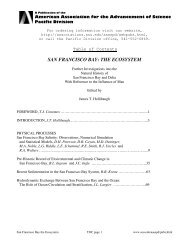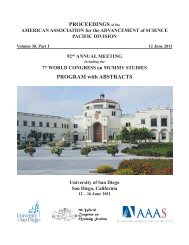Vol 31, Part I - forums.sou.edu ⢠Index page - Southern Oregon ...
Vol 31, Part I - forums.sou.edu ⢠Index page - Southern Oregon ...
Vol 31, Part I - forums.sou.edu ⢠Index page - Southern Oregon ...
You also want an ePaper? Increase the reach of your titles
YUMPU automatically turns print PDFs into web optimized ePapers that Google loves.
ABSTRACTS – Symposia<br />
Biophysical Insights from Experimental<br />
Approaches to Computational Simulations<br />
Wednesday, 8:30 a.m. in WILLOWS 1 & 2<br />
94 Discovery of a Nanoscale Clamp for Protein and Chromatin<br />
Binding, RICCARDO BARON (Department of Medicinal<br />
Chemistry, College of Pharmacy, The Henry Eyring Center<br />
for Theoretical Chemistry, University of Utah, 30 S 200<br />
E Room 201, Salt Lake City, UT 84112; nidia.martinez@<br />
gmail.com).<br />
LSD1 associated with its corepressor protein CoREST<br />
is an exceptionally relevant target for epigenetic drugs.<br />
Hypotheses for the role of LSD1/ CoREST as a multidocking<br />
site for chromatin and protein binding would require<br />
significant molecular flexibility, and LSD1/CoREST largeamplitude<br />
conformational dynamics is currently unknown.<br />
Our molecular dynamics simulations reveals that the LSD1/<br />
CoREST complex in solution functions as a reversible<br />
nanoscale binding clamp. We show that the H3 histone tail<br />
binding pocket is an allosteric site for regulation of the rotation<br />
of SWIRM/ SANT2 domains around the Tower domain.<br />
Thus, targeting this site and including receptor flexibility are<br />
crucial strategies for future drug discovery.<br />
95 Deconstructing and Reconstructing a Protein Capsid,<br />
KENNETH WOYCECHOWSKY (Department of Chemistry,<br />
Universtiy of Utah, <strong>31</strong>5 S 1400 E Room 2020, Salt<br />
Lake City, UT 84112; kwoycech@chem.utah.<strong>edu</strong>).<br />
Icosahedral protein capsids are often used in Nature for<br />
the storage, transport, or regulation of encapsulated cargo<br />
molecules. These structures are attractive for various applications<br />
in bionanotechnology, such as drug delivery and<br />
catalysis. Towards these ends, the usefulness of protein capsids<br />
will depend upon an understanding of their supramolecular<br />
chemistry. Lumazine synthase from Aquifex aeolicus<br />
(AaLS) self-assembles into a 60-subunit dodecahedral capsid<br />
and provides an appealing scaffold for engineering novel<br />
encapsulation systems. However, an inability to control<br />
AaLS capsid assembly has presented a major obstacle for<br />
cargo loading in vitro. Here, we use structure-guided design<br />
to identify a set of three amino acids that act as important<br />
determinants of capsid assembly. Simultaneous mutagenesis<br />
of these three residues prevents capsid formation, halting<br />
self-assembly at the pentameric stage. This pentameric AaLS<br />
variant provides the basis for engineering a redox switch to<br />
build 60-subunit capsids in vitro. The capsid assembly process<br />
involves the formation of a covalent adduct between a<br />
unique cysteine in the variant (C37A/R40S/H41S/I125C-<br />
AaLS) and thiophenol. This modification adds non-polar<br />
surface area at position 125, presumably recapitulating a key<br />
feature of the isoleucine present at this position in the wildtype<br />
protein. The spontaneous, non-covalent assembly of the<br />
thiophenol-modified pentamers yields capsids that resemble<br />
those of wild-type AaLS, as assessed by size-exclusion<br />
chromatography and electron microscopy. Further, we have<br />
used this assembly switch to encapsulate the enzyme horseradish<br />
peroxidase, which remains active inside the capsid.<br />
By understanding the structural determinants for AaLS capsid<br />
assembly, we are able to deconstruct this capsid into its<br />
constituent pentamers by mutagenesis and reconstruct the<br />
capsid by chemical modification. Control of capsid assembly<br />
enables the encapsulation of enzymes and other molecules in<br />
vitro, which should prove useful in the construction of novel<br />
drug delivery and catalytic systems.<br />
96 Determining Realistic Structural Ensembles for Intrinsically<br />
Disordered Proteins, F MARTY YTREBERG<br />
(Department of Physics, University of Idaho, Moscow, ID<br />
83844; ytreberg@uidaho.<strong>edu</strong>).<br />
Intrinsically disordered proteins (IDPs) are common in<br />
humans and their dysfunction is associated with many human<br />
diseases. IDPs are highly dynamic, contain varying amounts<br />
of transient secondary structure, and rarely have tertiary<br />
interactions. Given these structural features, most experimental<br />
and computational methods in structural biology are<br />
not suitable for IDPs. I will describe our new approach that<br />
combines experiment and simulation to generate structures<br />
for IDPs using the transactivation domain of tumor suppressor<br />
protein p53 as a model system; one of the most commonly<br />
mutated genes found in human tumors. Results from<br />
our study show that, while independent IDP ensembles do<br />
not appear to be structurally similar, one can calculate features<br />
that are consistent between ensembles. These findings<br />
suggest that the consistent features have biological significance,<br />
and that one should gauge the quality of the ensembles<br />
based on the ability to reproduce these features.<br />
97 Chromatographic Stationary Phase Development for<br />
the Analysis of Solute Interactions with Phospholipid Membranes,<br />
ERIC E ROSS (Department of Chemistry and Biochemistry,<br />
Gonzaga University 502 East Boone Avenue,<br />
Spokane, WA 99258-0102; rosse@gonzaga.<strong>edu</strong>).<br />
The retention time of a solute in chromatography is<br />
related to its partition or binding behavior between stationary<br />
and mobile phases. The specific research utility of a<br />
chromatographic system designed to probe biomembrane<br />
interactions is a factor of the replicated membrane attributes,<br />
the chromatographic efficiency of the materials, and<br />
the system’s compatibility with various chromatographic<br />
formats. The most realistic membrane models used to date<br />
for chromatography, such as gel-supported liposomes, are<br />
compatible with the least efficient and most performancelimited<br />
supports, while higher performing materials based<br />
on covalently derivatized solids replicate fewer membrane<br />
attributes. This research describes the development of new<br />
materials composed of dynamic lipid bilayers supported<br />
within porous particles that are fabricated from Stöber silica<br />
colloids. Preliminary results obtained in a high performance<br />
75








